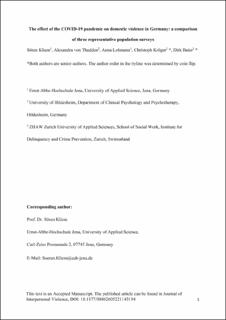Please use this identifier to cite or link to this item:
https://doi.org/10.21256/zhaw-26699Full metadata record
| DC Field | Value | Language |
|---|---|---|
| dc.contributor.author | Kliem, Sören | - |
| dc.contributor.author | von Thadden, Alexandra | - |
| dc.contributor.author | Lohmann, Anna | - |
| dc.contributor.author | Kröger, Christoph | - |
| dc.contributor.author | Baier, Dirk | - |
| dc.date.accessioned | 2023-01-26T09:01:48Z | - |
| dc.date.available | 2023-01-26T09:01:48Z | - |
| dc.date.issued | 2023 | - |
| dc.identifier.issn | 0886-2605 | de_CH |
| dc.identifier.issn | 1552-6518 | de_CH |
| dc.identifier.uri | https://digitalcollection.zhaw.ch/handle/11475/26699 | - |
| dc.description | Verfügbar in der Sage Public Health Emergency Collection: https://www.ncbi.nlm.nih.gov/pmc/articles/PMC9849116/ | de_CH |
| dc.description.abstract | The COVID-19 pandemic has had profound societal and economic effects. Concerns were raised that domestic violence might increase because of the enacted infection control measures. Previous findings on this issue have been contradictory. Since existing studies mainly rely on official reports, administrative data, helpline calls, or retrospective measures, their findings are likely to prove unreliable. Few population-based surveys include pre-pandemic data, limiting their ability to test for causality regarding increasing violence. Therefore, the aim of this study was to compare findings from population-representative surveys on the prevalence of intimate partner violence (IPV) and violence against children (VAC) before and during the COVID-19 pandemic. Based on the data of N = 3,639 individuals living with a romantic partner and N = 1,313 parents living with at least one of their children from three German representative population surveys, we estimated average marginal effects for the temporal trends (i.e., pre vs. post infection control measures) of domestic violence separately for males and females. To minimize bias across survey waves, inverse probability weighting was used. Results show no statistically significant increase in either physical or psychological forms of IPV or VAC as a result of the implementation of COVID measures. On the contrary, the 1-year prevalence was decreasing for certain forms of violence. Our findings suggest that the assessment of the consequences of infection control measures needs an empirical basis. Further research should be conducted using high-quality data sources. Therefore, the present study should be considered a stepping stone for ongoing research efforts to examine the consequences of pandemic-related infection control measures on the general population. | de_CH |
| dc.language.iso | en | de_CH |
| dc.publisher | Sage | de_CH |
| dc.relation.ispartof | Journal of Interpersonal Violence | de_CH |
| dc.rights | Licence according to publishing contract | de_CH |
| dc.subject | Assessment | de_CH |
| dc.subject | Mental health and violence | de_CH |
| dc.subject | Child abuse | de_CH |
| dc.subject | Domestic violence | de_CH |
| dc.subject | Covid-19 | de_CH |
| dc.subject.ddc | 306.8: Familiensoziologie | de_CH |
| dc.subject.ddc | 362: Gesundheits- und Sozialdienste | de_CH |
| dc.title | The effect of the Covid-19 pandemic on domestic violence in Germany : a comparison of three representative population surveys | de_CH |
| dc.type | Beitrag in wissenschaftlicher Zeitschrift | de_CH |
| dcterms.type | Text | de_CH |
| zhaw.departement | Soziale Arbeit | de_CH |
| zhaw.organisationalunit | Institut für Delinquenz und Kriminalprävention (IDK) | de_CH |
| dc.identifier.doi | 10.1177/08862605221143194 | de_CH |
| dc.identifier.doi | 10.21256/zhaw-26699 | - |
| dc.identifier.pmid | 36636865 | de_CH |
| zhaw.funding.eu | No | de_CH |
| zhaw.issue | 11-12 | de_CH |
| zhaw.originated.zhaw | Yes | de_CH |
| zhaw.pages.end | 7314 | de_CH |
| zhaw.pages.start | 7296 | de_CH |
| zhaw.publication.status | acceptedVersion | de_CH |
| zhaw.volume | 38 | de_CH |
| zhaw.publication.review | Peer review (Publikation) | de_CH |
| zhaw.webfeed | Gewalt im sozialen Nahraum | de_CH |
| zhaw.author.additional | No | de_CH |
| zhaw.display.portrait | Yes | de_CH |
| Appears in collections: | Publikationen Soziale Arbeit | |
Files in This Item:
| File | Description | Size | Format | |
|---|---|---|---|---|
| 2023_Kliem-etal_The-effect-of-the-COVID-19-pandemic-on-domestic-violence-in-Germany_JIV_AMM.pdf | Accepted Version | 445.48 kB | Adobe PDF |  View/Open |
Show simple item record
Kliem, S., von Thadden, A., Lohmann, A., Kröger, C., & Baier, D. (2023). The effect of the Covid-19 pandemic on domestic violence in Germany : a comparison of three representative population surveys. Journal of Interpersonal Violence, 38(11-12), 7296–7314. https://doi.org/10.1177/08862605221143194
Kliem, S. et al. (2023) ‘The effect of the Covid-19 pandemic on domestic violence in Germany : a comparison of three representative population surveys’, Journal of Interpersonal Violence, 38(11-12), pp. 7296–7314. Available at: https://doi.org/10.1177/08862605221143194.
S. Kliem, A. von Thadden, A. Lohmann, C. Kröger, and D. Baier, “The effect of the Covid-19 pandemic on domestic violence in Germany : a comparison of three representative population surveys,” Journal of Interpersonal Violence, vol. 38, no. 11-12, pp. 7296–7314, 2023, doi: 10.1177/08862605221143194.
KLIEM, Sören, Alexandra VON THADDEN, Anna LOHMANN, Christoph KRÖGER und Dirk BAIER, 2023. The effect of the Covid-19 pandemic on domestic violence in Germany : a comparison of three representative population surveys. Journal of Interpersonal Violence. 2023. Bd. 38, Nr. 11-12, S. 7296–7314. DOI 10.1177/08862605221143194
Kliem, Sören, Alexandra von Thadden, Anna Lohmann, Christoph Kröger, and Dirk Baier. 2023. “The Effect of the Covid-19 Pandemic on Domestic Violence in Germany : A Comparison of Three Representative Population Surveys.” Journal of Interpersonal Violence 38 (11-12): 7296–7314. https://doi.org/10.1177/08862605221143194.
Kliem, Sören, et al. “The Effect of the Covid-19 Pandemic on Domestic Violence in Germany : A Comparison of Three Representative Population Surveys.” Journal of Interpersonal Violence, vol. 38, no. 11-12, 2023, pp. 7296–314, https://doi.org/10.1177/08862605221143194.
Items in DSpace are protected by copyright, with all rights reserved, unless otherwise indicated.